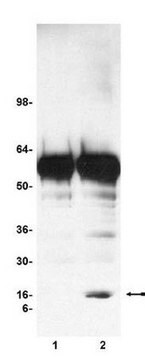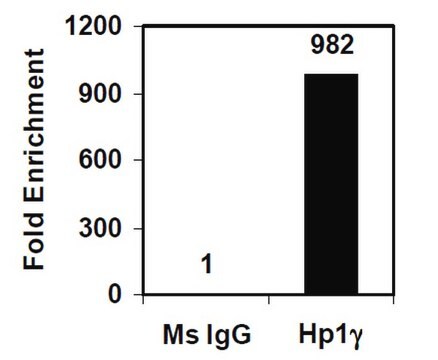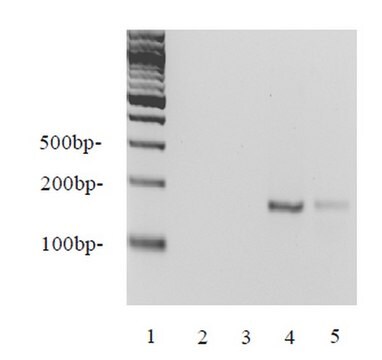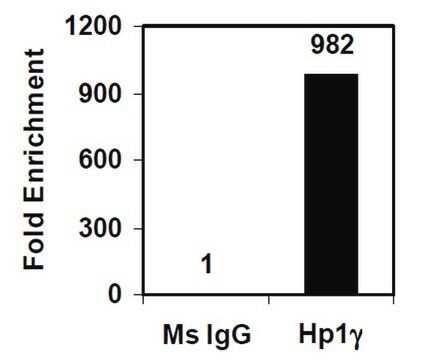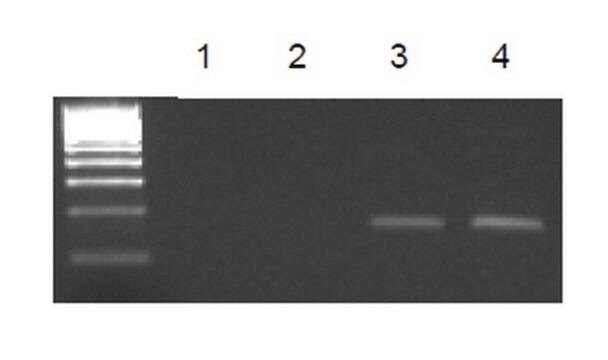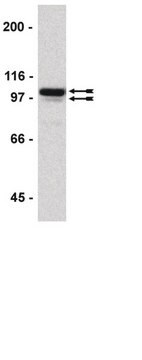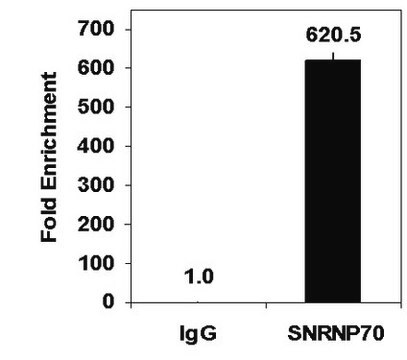17-371
EZ-ChIP
Synonyme(s) :
Chromatin Immunoprecipitation Kit
About This Item
Produits recommandés
Description
22 individual chromatin immunoprecipitation (ChIP) reactions using inexpensive protein G agarose beads
Niveau de qualité
Conditionnement
kit of 22 assay(s)
Technique(s)
immunoprecipitation (IP): suitable
Description générale
Chromatin Immunoprecipitation (ChIP) is a powerful technique for mapping the in vivo distribution of proteins associated with chromosomal DNA. These proteins can be histone subunits and post-translational modifications or other chromatin associated proteins such as transcription factors, chromatin regulators, etc. Additionally, ChIP can be used to identify regions of the genome associated with these proteins, or conversely, to identify proteins associated with a particular region of the genome. ChIP methodology often involves protein-DNA and protein-protein cross-linking, fragmentation of the cross-linked chromatin, and subsequent immunoprecipitation of chromatin with an antibody specific to a target protein. The DNA fragments isolated in complex with the target protein can be identified by a variety of methods including PCR, DNA microarray and DNA sequencing. Standard or quantitative PCR can be performed to verify whether a particular DNA sequence (the gene or region of the genome) is associated with the protein of interest. The combination of ChIP and promoter or genomic tiling microarrays (ChIP-chip) allows genome-wide identification of DNA-binding sites for chromatin-associated proteins with precise resolution. Alternatively, high-throughput sequencing of libraries constructed from immunoprecipitated chromosomal DNA (ChIP-Seq) is a powerful alternative to ChIP-chip in mapping the protein-DNA interactions across mammalian genomes.
Caractéristiques et avantages
- Easier: Spin columns make DNA purification easier and more reliable - no more messy phenol-chloroform extractions.
- Quicker: All reagents to process your samples are included - you don′t have to spend valuable time making them.
- Greater Reproducibility: Positive and negative control antibodies and PCR primers are included to help validate your results and to troubleshoot your experiments.
Conditionnement
Composants
- DNA Purification Spin Columns and Collection Tubes
- ChIP Blocked Protein G Agarose
- Anti-RNA Polymerase II
- Control PCR Primers
- Normal Mouse IgG
- Bind, Wash and Elution Reagents
- Protease Inhibitor Cocktail II
- RNase A
- Proteinase K
- All required buffers
- ChIP Dilution Buffer
- Low Salt Immune Complex Wash Buffer
- High Salt Immune Complex Wash Buffer
- LiCl Immune Complex Wash Buffer
- TE Buffer
- 0.5M EDTA
- 5M NaCl
- SDS Lysis Buffer
- 1M Tris-HCl, pH 6.5
- 10X PBS
- 10X Glycine
- 1M NaHCO3
- Control Primers
- 20% SDS
- Spin Filters
- Collection Tubes
- Bind Reagent A
- Wash Reagent B
- Elution Reagent C
Stockage et stabilité
Clause de non-responsabilité
Mention d'avertissement
Danger
Mentions de danger
Conseils de prudence
Classification des risques
Acute Tox. 4 Oral - Aquatic Chronic 3 - Eye Dam. 1 - Flam. Liq. 2 - Resp. Sens. 1 - Skin Irrit. 2
Code de la classe de stockage
3 - Flammable liquids
Classe de danger pour l'eau (WGK)
WGK 2
Point d'éclair (°F)
55.4 °F
Point d'éclair (°C)
13 °C
Certificats d'analyse (COA)
Recherchez un Certificats d'analyse (COA) en saisissant le numéro de lot du produit. Les numéros de lot figurent sur l'étiquette du produit après les mots "Lot" ou "Batch".
Déjà en possession de ce produit ?
Retrouvez la documentation relative aux produits que vous avez récemment achetés dans la Bibliothèque de documents.
Notre équipe de scientifiques dispose d'une expérience dans tous les secteurs de la recherche, notamment en sciences de la vie, science des matériaux, synthèse chimique, chromatographie, analyse et dans de nombreux autres domaines..
Contacter notre Service technique